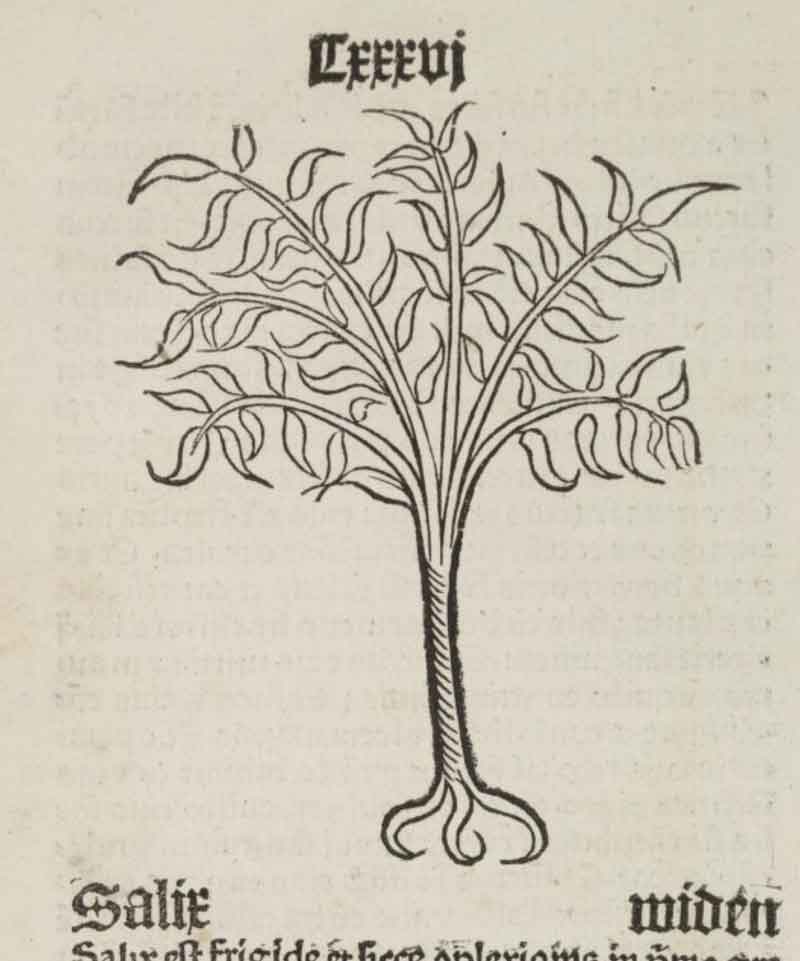the seed of willow, to vicious nuns;
Original French: la ſemence de Saule, aux Nonnains vitieuſes:
Modern French: la semence de Saule, aux Nonnains vitieuses:
Among the examples of pairings whose antipathies are not as vehement as the hatred thieves have of a certain usage of Pantagruelion.
Notes
Salix
la semence de Saule, aux Nonnains vitieuses
But when in thy ship thou hast now crossed the stream of Oceanus, where is a level shore and the groves of Persephone— tall poplars, and willows that shed their fruit—there do thou beach thy ship by the deep eddying Oceanus, but go thyself to the dank house of Hades.
seed of willow
ocissime autem salix amittit semen, antequam omnino maturitatem sentiat, ob id dicta Homero frugiperda; secuta aetas scelere suo interpretata est hanc sententiam, quando semen salicis mulieri sterilitatis medicamentum esse constat. sed in hoc quoque providens natura facile nascenti et depacto surculo incuriosius semen dedit
But it is the willow that loses its seed most quickly, before it approaches ripeness at all. This is the reason why Homer gives it the epithet ‘fruit-losing’; but succeeding ages have interpreted the meaning of the word in the light of its own wicked conduct, inasmuch as it is well known that willow seed taken as a drug produces barrenness in a woman. But Nature, showing her foresight in this matter also, has been rather careless about bestowing seed on a tree that is propagated easily even from a planted sprig.
Willow-seed to vicious Nuns
Pliny xvi. 26, § 46. Homer, Od. x. 510.
Chapter 31. How Rondibilis the Physician counselleth Panurge
[re. Hempseed]
Chapter 31. How Rondibilis the Physician counselleth Panurge
I find in our faculty of Medicine — and we have taken it from the Determination of the ancient Platonics — that carnal Concupiscence is restrained by five means.
By wine…
Secondly, by certain drugs and plants. which make a man chilled, bewitched, and impotent for generation. We have experience of it in Nymphea [25.7.37], Heraclea, Willow of Ameria [24.9.37], Hemp-seed [20.23.97], Honey-suckle [27.12.94], Tamarisk [24.9.41], Agnus-castus[24.9.38], Mandrake [24.13.94], Hemlock [25.13.95], the small Orchis [26.10.62; HP 9.18.3], the Skin of Hippopotamus [28.8.31], and others, which, received within the human Body, by their elementary Virtues as well as by their specific Properties, freeze and mortify the prolific Germ, or dissipate the Spirits which ought to conduct it to the Places destined for it by Nature, or obstruct the Passages and Conduits, by which it might have been ejected…
[notes from Pliny]
la semence de saule aux nonnains vitieuses
«Semen salicis mulieri sterilitatis medicamentum esse constat», dit Pline, XVI, 46. «L’écorce, les feuilles et la semence du Saule sont astringentes et rafrîchissantes, dit Lemery; on en fait prendre la décoction pour arrêter les ardeurs de Vénus». (Dict. les drogues simples, p. 770.) La pharmacopée emploie encore comme antispasmodique le Salix nigra. (Paul Delaunay)
Nenuphar…
Encore une fois, la plupart de ces exemples se retrouvent dans le De latinis nominibus de Charles Estienne. Le nenufar et la semence de saule sont des antiaphrodisiaques. La ferula servait, dans l’Antiquité, à fustiger les écoliers (cf. Martial, X, 62-10).
la semence de Saule, aux Nonnains vitieuses:
Considérée comme antiaphrodisiaque.
